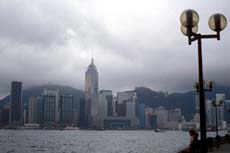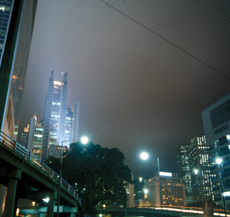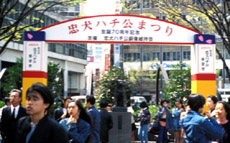index
Hong Kong versus Tokyo
click on images for full-size:





Central in Hong Kong, seen from Kowloon

Central at night

Tokyo roofs

At the Hachiko meeting place at Shibuya Station, Tokyo, posters announce a festival in honor of the faithful dog (who came to the station every day for years to await his dead master's return)
Hong Kong can make Tokyo seem uncrowded. That's not exactly true, of course; Tokyo's subways seem more crowded, but many Tokyo streets are edged by lower buildings, while Hong Kong streets are deep valleys with rushing rivers flowing through them. Hong Kong people seem more energetic in the street; perhaps that goes along with the famous Hong Kong abruptness. Another reason for the crowded effect is that Hong Kong has a form. Hills and water close in the city and carve it into many areas and views. They give Hong Kong a shape, though not a shape that you can see entire from any one point, even from Victoria Peak. There is no visual sense of an overall shape, but there is always local shape; you get the feeling that there will always be more corners with new bays and hills defining new areas all packed with highrises. Tokyo also has many subsidiary centers but the overall city spreads out indefinitely in all directions. Tokyo Bay is there, but it is not a visual presence in the city except from a few spots, and it seems shapeless, its coast often unapproachable and blurred by industrial extensions. The River Sumida once gave shape to the city, and still defines an exciting corridor, but the city's center of visual and economic gravity has moved away from that axis. So there are few distinctions imposed by the landscape. Yet Tokyo has a pattern despite its shaplessness. If you know the city your visualization of its form likely depends on the transit lines radiating out from a central circle into the hinterlands. Because there is no surrounding wall of hills and because the city is mostly low, its density decompresses as you travel outward. So despite the lack of any dominating landscape feature, the Yamanote area is experienced as a center. And in the very center, as many have pointed out, there is an inversion; the Imperial Palace area stands visually empty, a piece of the far off woodlands. From even one block away that low central void vanishes. Like the far periphery, it functions without being seen. The city's shape is never presented, but it is felt.